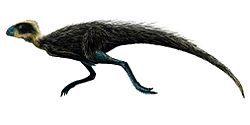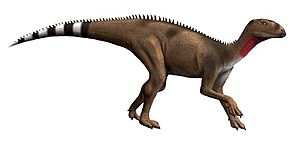Pisanosaurus facts for kids
Quick facts for kids PisanosaurusTemporal range: Upper Triassic, 228–216.5 mya
|
|
|---|---|
 |
|
| Scientific classification | |
| Kingdom: | |
| Phylum: | |
| Class: | |
| Superorder: | |
| Order: | |
| Family: |
Pisanosauridae
Casamiquela, 1967
|
| Genus: |
Pisanosaurus
Casamiquela, 1967
|
Pisanosaurus was an ancient animal that lived a very long time ago, about 228 to 216 million years ago. It lived during the late Triassic Period in what is now South America. This small creature was a herbivore, meaning it ate plants. It walked on the ground and could grow up to about 1 m (3.3 ft) long.
Scientists only know about one type of Pisanosaurus, called Pisanosaurus mertii. We know about it from a single partial skeleton found in Argentina. This fossil was discovered in the Ischigualasto Formation.
Contents
What Kind of Animal Was Pisanosaurus?
Scientists have discussed exactly where Pisanosaurus fits in the animal family tree for over 40 years. For a long time, most experts thought it was the oldest known ornithischian. Ornithischians are a big group of dinosaurs that lived for almost the entire Mesozoic Era.
However, more recently, some scientists have started to think that Pisanosaurus might not have been a dinosaur at all. They suggest it was a non-dinosaurian silesaurid. Silesaurids were close relatives of dinosaurs.
What Did Pisanosaurus Look Like?
Based on the fossil bones found, Pisanosaurus was a small and lightly built animal. It was about 1 m (3 ft 3 in) long. Its weight might have been anywhere from 2.27–9.1 kg (5–20 lb). These numbers are estimates because the fossil skeleton is not complete.
Scientists like José Bonaparte have studied the bones of Pisanosaurus closely. They found some special features. For example, the hip-joint, called the acetabulum, was open. Also, the upper part of its hip bone (ischium) was wider than its pubic bone. The bones in its hand, called metacarpals, were quite long, about fifteen millimeters.
Images for kids
-
A reconstructed skeleton of Pisanosaurus at the Royal Ontario Museum. This shows how it was traditionally seen as an ornithischian dinosaur.
See also
 In Spanish: Pisanosaurus mertii para niños
In Spanish: Pisanosaurus mertii para niños



